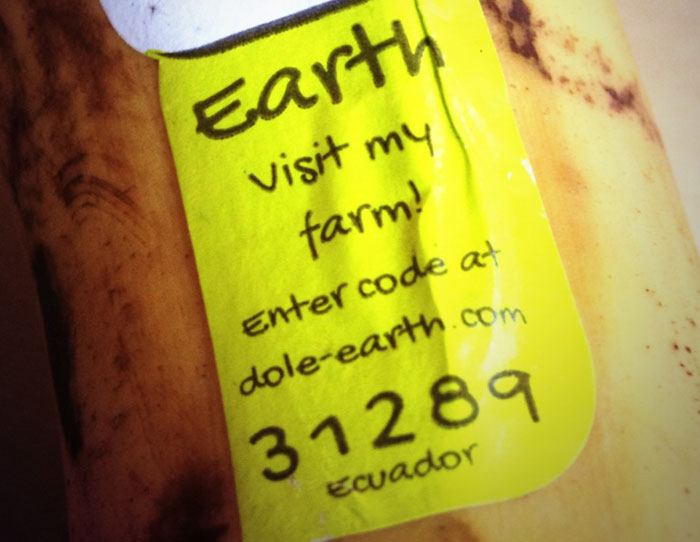I was getting ready to eat my banana, when I noticed the sticker was a bit different. This normally banal brand label had something extra, something out of the ordinary. The sticker read: Earth visit my farm! Enter code at dole-earth.com 31289 Ecuador
When you follow the link, it takes you to a single page dedicated to information about that farm. This is a really interesting start to knowing where you food is grown, how it is managed and other background information.
On a side note, see how they give you a URL and ask you to type a small 5 digit code. They didn’t try to make a tiny QR code, tell people to go download an app, then come back to the banana and take a photo of the barcode to get to a non-cryptic URL anyway. I am really glad they went with the simple route rather than falling into the trendy trap of barcodes.
When you type all the information in, you end-up at this URL: http://www.dole.eu/dole-earth/farm/31289.html
It contains a bit more information about the farm, the climate and community. It is a bit of a marketing project, but at least it is a start to get people asking about the origins of their food. Maybe eventually, it will have more machine readable information as well as deeper data into pesticide use, shipping methods, and suppliers in the chain.
This has been an idea we regularly come back to as a potential internal project. Working more on something to track and view the entire supply line. I’ve always been struck by the idea that going local, while most of the time is good, is not always the best. One example (and it might not be true) is that when you add in all the carbon used, buying a sheep in the UK which is near by, is actually worse from a carbon-offsetting point of view, than a sheep from New Zealand which has transported to the UK. Sure, getting that sheep to the UK caused a lot of carbon, but up until that point that the rearing of that sheep consumed very little. In the UK, all the food that sheep ate needed to be transported to it, the carbon from the farm, etc. All these hidden costs made the locally sourced sheep worse than some from afar. Now, that’s not always the case, but it shows that building some sort of tracking application to determine the quality, worth and provenance of the food you are eating isn’t easy.
We struggle with how it could be possible to track, gather and visualize food carbon data. Without controlling the entire chain, it is always an estimate. Our first, and simplest pass, was to look at the barcodes. They are regionally assigned, so in a grocery store, you can look at the products and see where they were produced. For somewhere like Iceland, that sits nicely between North America and Europe, we see a lot of mixed products. Beyond country of packaging, it is hard to know where the ingredients came from or how they were grown.
I am excited to see this “visit my farm initiative”. Their bananas and other fruits are much easier to track since it is a single ingredient. Banana’s also don’t have the best reputation for being sustainable, with the pesticides, killer fungus, shipping unripe with chemicals to fast ripen, revolutions and a history of maltreatment of workers, this is a start to repair their reputations with the consumer.
If other companies begin to also offer, or we as consumers demand, a way to see the history of the object, then we all begin to win. Dole has done it, even when they didn’t have to. Now it will be a much hard excuse for other companies not to be participating in this way.
